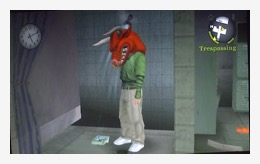24 - Bully (Canis Canem Edit)
Become a Patron!

Thanks as always to my supporters on Patreon — especially my $10+ backers Vivek Mohan, Simon Moss, Wade Tregaskis, Eric Zocher, and Seth Robinson. If you'd like to become a supporter, for as little as $1 a month, head to my Patreon page and sign up. Or for one-off donations you can use paypal.me/mossrc.
Please remember to tell other people about the show, and to leave a review by following the links at ratethispodcast.com/ltvg.
My book, The Secret History of Mac Gaming, is available in bookstores in the UK and Australia, as well as online from the likes of Book Depository and Amazon. See the official website for more info.
(Partial) Transcript
If it were a movie, Bully might have been painted as a poignant tale of growing up, finding your place, and standing up for what’s right — weaved into a John Hughes-esque schoolyard satire.Instead…well, this happened:
[audio clip]
That clip is from a segment on G4TV’s Attack of the Show from before Bully came out, when lawyer Jack Thompson (who later got disbarred) spoke on behalf of the anti-videogame violence activists and parents’ groups — none of whom had played Bully or even seen the game in action, but all of whom had apparently assumed that it’s a high school shooting and bullying simulator from the makers of what they had previously argued was a prostitute murder simulator.
They fought for it to be banned. And they weren’t entirely unsuccessful in their efforts, as multiple major retail stores in the UK and US refused to stock it and Brazil banned it entirely.
The uproar reached such fever pitch that developer Rockstar was forced to release the game under a different, less-obviously-provocative name in PAL territories in order to fend off the attacks — Canis Canem Edit, they called it outside America; Latin for dog eat dog, the motto at fictional school Bullworth Academy, where it served as a clever metaphor not only for the game’s plot but also for the overblown controversies that Rockstar kept stumbling into.
And for that reason — that it's not even remotely close to being a Columbine Simulator — it’s the game, more than the controversies around it, that I want to talk about here. The game that should have been the focus of attention, for how — and how well — it deals with its subject matter. Because there shouldn’t have been anything controversial about that subject matter.
***
On the surface level, Bully follows a misfit teenager flung off to boarding school by a neglectful mother, while she takes a year-long honeymoon with her creepy new husband. This teenager, Jimmy, is left to fend for himself in a world of entrenched cliques, rampant bullying, authoritarian teachers, and, of course, daily classes that he’s expected to attend — because it is a school, after all.
The idea was not without precedence in the video game world. One of the best games of the mid-1980s, and the likely subject of a future episode, had done essentially the same thing. Skool Daze by David and Helen Reidy followed the exploits of a British schoolboy as he endeavours to steal his report card — by whatever means the player can devise. In the ensuing open-ended adventure you’d need to deal with the school bully and various other kids as they try to stir up trouble for you with the teachers.
So in mechanical terms, Skool Daze was a game of mischief. Mischief-making, mischief-seeking, and mischief-avoiding. Like Bully, except that Bully had 22 years of additional technological advancement behind it, plus an army of additional developers to fill it with stuff, and a rather more pointed bit of social commentary coursing through its veins.
[clip from the game]
It’s here, where Bully takes on problems with societal structure and Western culture, that I think it’s at its strongest. Where the game is, as Bully co-writer Dan Houser once said, “a response to the institutionalised categorisation of people.” But let’s come back to that later. Let’s build up to that with some context, and some history.
(For more, including the tale of how Warcraft II got its two-tiered fog of war system, and how the fog of war continued its march deeper into the industry, you'll have to either just listen to the episode or sign up as a supporter on Patreon — everyone who pledges $3 or more a month gets access to full episode transcripts [amongst other things].)



